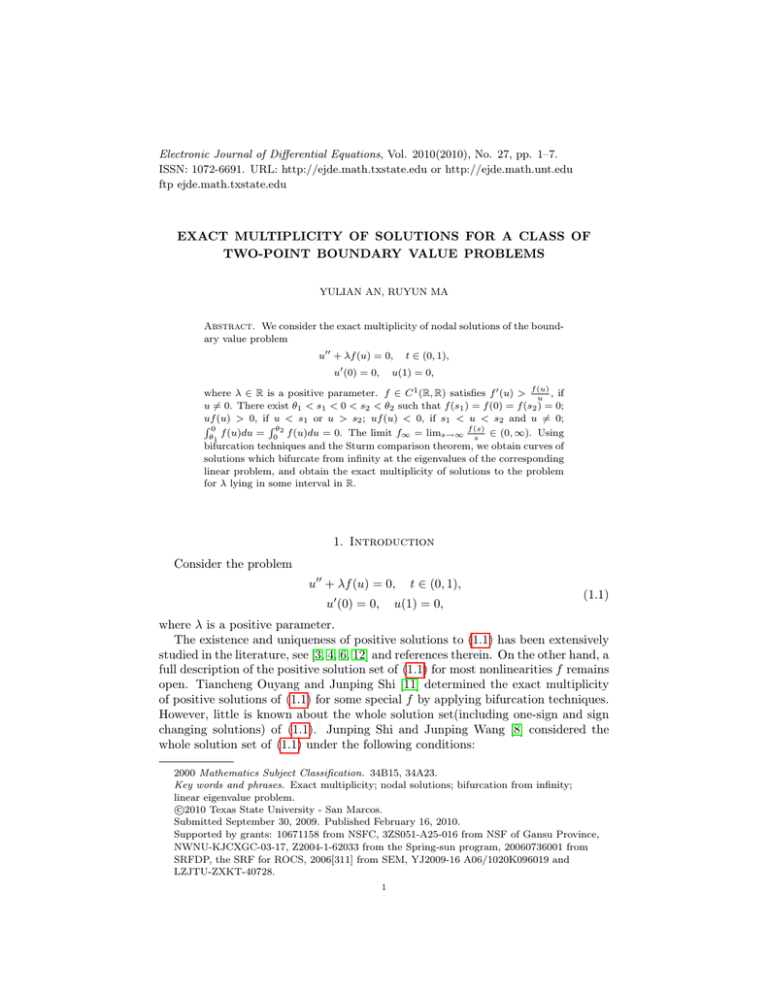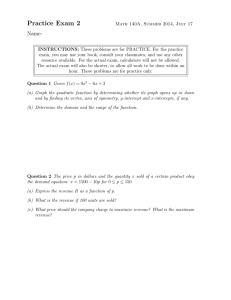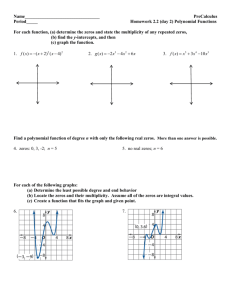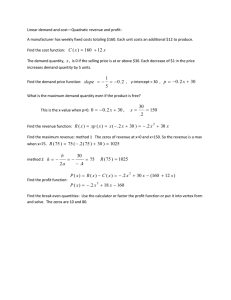Electronic Journal of Differential Equations, Vol. 2010(2010), No. 27, pp.... ISSN: 1072-6691. URL: or
advertisement

Electronic Journal of Differential Equations, Vol. 2010(2010), No. 27, pp. 1–7.
ISSN: 1072-6691. URL: http://ejde.math.txstate.edu or http://ejde.math.unt.edu
ftp ejde.math.txstate.edu
EXACT MULTIPLICITY OF SOLUTIONS FOR A CLASS OF
TWO-POINT BOUNDARY VALUE PROBLEMS
YULIAN AN, RUYUN MA
Abstract. We consider the exact multiplicity of nodal solutions of the boundary value problem
u00 + λf (u) = 0,
u0 (0) = 0,
t ∈ (0, 1),
u(1) = 0,
f (u)
where λ ∈ R is a positive parameter. f ∈ C 1 (R, R) satisfies f 0 (u) > u , if
u 6= 0. There exist θ1 < s1 < 0 < s2 < θ2 such that f (s1 ) = f (0) = f (s2 ) = 0;
uf (u) > 0, if u < s1 or u > s2 ; uf (u) < 0, if s1 < u < s2 and u 6= 0;
R0
R θ2
f (s)
∈ (0, ∞). Using
θ1 f (u)du = 0 f (u)du = 0. The limit f∞ = lims→∞ s
bifurcation techniques and the Sturm comparison theorem, we obtain curves of
solutions which bifurcate from infinity at the eigenvalues of the corresponding
linear problem, and obtain the exact multiplicity of solutions to the problem
for λ lying in some interval in R.
1. Introduction
Consider the problem
u00 + λf (u) = 0,
0
u (0) = 0,
t ∈ (0, 1),
u(1) = 0,
(1.1)
where λ is a positive parameter.
The existence and uniqueness of positive solutions to (1.1) has been extensively
studied in the literature, see [3, 4, 6, 12] and references therein. On the other hand, a
full description of the positive solution set of (1.1) for most nonlinearities f remains
open. Tiancheng Ouyang and Junping Shi [11] determined the exact multiplicity
of positive solutions of (1.1) for some special f by applying bifurcation techniques.
However, little is known about the whole solution set(including one-sign and sign
changing solutions) of (1.1). Junping Shi and Junping Wang [8] considered the
whole solution set of (1.1) under the following conditions:
2000 Mathematics Subject Classification. 34B15, 34A23.
Key words and phrases. Exact multiplicity; nodal solutions; bifurcation from infinity;
linear eigenvalue problem.
c
2010
Texas State University - San Marcos.
Submitted September 30, 2009. Published February 16, 2010.
Supported by grants: 10671158 from NSFC, 3ZS051-A25-016 from NSF of Gansu Province,
NWNU-KJCXGC-03-17, Z2004-1-62033 from the Spring-sun program, 20060736001 from
SRFDP, the SRF for ROCS, 2006[311] from SEM, YJ2009-16 A06/1020K096019 and
LZJTU-ZXKT-40728.
1
2
Y. AN, R. MA
EJDE-2010/27
(C1) f ∈ C 1 (R, R) satisfies f (0) = 0, f 0 (0) > 0;
(C2) f 0 (u) > f (u)
u , if u 6= 0;
(C3) The limit f∞ = lims→∞ f (s)
s ∈ (0, ∞).
They obtained a full description of the the first N solution curves which bifurcate
from the line of trivial solutions. Anuradha and Shivaji [1] gave some similar results
where f satisfied f (0) < 0 and other conditions. Motivated by these works, we will
consider the existence and uniqueness of one-sign and sign changing solutions of
(1.1) under the following conditions
(H1) f ∈ C 1 (R, R), f 0 (u) > f (u)
u , if u 6= 0;
(H2) the limit f∞ = lim|s|→∞ f (s)
s ∈ (0, ∞);
(H3) There exist θ1 < s1 < 0 < s2 < θ2 such that f (s1 ) = f (0) = f (s2 ) = 0;
uf (u) > 0, if u < s1 or u > s2 ; uf (u) < 0, if s1 < u < s2 and u 6= 0;
R0
Rθ
f (u)du = 0 2 f (u)du = 0.
θ1
We obtain curves of one-sign and sign changing solutions of (1.1), bifurcating
from ∞ at the eigenvalues of the corresponding linear problem of (1.1), and obtain
exact multiplicity of one-sign and sign changing solutions of (1.1) for λ lying in
some interval in R.
Remark 1.1. Shi and Wang [8] gave precise global bifurcation structure for the
whole solution set of (1.1) when the nonlinearity f satisfying f 0 (0) > 0. However,
(H3) implies that f 0 (0) < 0. Meanwhile, (C1) and (C2) implies that f (u)u > 0,
if u 6= 0, but f (u)u has negative parts if f satisfying (H3). So it is interesting to
find precise global bifurcation structure for the whole solution set of (1.1) under
the conditions (H1)-(H3).
Remark 1.2. The uniqueness and exact multiplicity of positive solutions have
been studied by many authors, see [5, 10] and the references therein. The exact
multiplicity results about sign changing solutions have also been researched, see
[1, 11] and the references therein. Bari and Rynne [2] consider the global structure
of the nodal solutions of the problem
(−1)m u(2m) (t) = λg(u(t))u(t),
u(i) (−1) = u(i) (1) = 0,
t ∈ (0, 1),
i = 0, . . . , m − 1,
where λ > 0 is a parameter, the function g ∈ C 1 (R, R) satisfying lim|ξ|→∞ g(ξ) =
∞, and g(0) > 0, ±g 0 (ξ) > 0, for all ±ξ > 0.
2. Preliminary results
Let Y = C[0, 1] with the norm kyk∞ = maxt∈[0,1] |y(t)|, and let
E = {y ∈ C 1 [0, 1] : y 0 (0) = y(1) = 0},
with the norm kykE = max{kyk∞ , ky 0 k∞ }. Define the operate L : D(L) ⊂ E → Y ,
by Lu := −u00 , u ∈ D(L), where
D(L) = {u ∈ C 2 [0, 1] : u0 (0) = u(1) = 0}.
Then L−1 : Y → E is a completely continuous operator and (1.1) is equivalent to
the operator equation
u − λL−1 (f (u)) = 0.
EJDE-2010/27
EXACT MULTIPLICITY OF SOLUTIONS
3
We introduce some notation to describe the nodal properties of solutions to (1.1).
Firstly, for any C 1 function u, x0 is a simple zero of u if u(x0 ) = 0 and u0 (x0 ) 6= 0.
Now, for any integer k ≥ 1 and any ν ∈ {+, −}, we define sets Skν ⊂ C 2 [0, 1] as
follows: if u ∈ Skν , then
(i) u0 (0) = 0, νu(0) > 0;
(ii) u has only simple zeros in [0, 1] and has exact k − 1 zeros in (0, 1).
The sets Skν are open in E and disjoint.
Let E = R × E, under the product topology. We add the point {(λ, ∞)p |λ ∈ R}
into the space E. Put Φνk = R × Skν .
Clearly, u ≡ 0 is a solution of (1.1) for any λ ∈ R. (λ, 0) is called a trivial solution
of (1.1). Note that (H1) ensures that the solution of the initial value problem for
the differential equation in (1.1) is unique. This fact will be used repeatedly in the
following proof so, for brevity, it will be abbreviated to “IVPU”.
We first prove the following result about the nodal properties of nontrivial solutions of (1.1).
Lemma 2.1. Suppose (λ, u) is a nontrivial solution of (1.1). Then
(i) u ∈ Skν for some k ∈ N and ν ∈ {+, −};
(ii) maxt∈[0,1] u(t) > θ2 and mint∈[0,1] u(t) < θ1 if k ≥ 2; maxt∈[0,1] u(t) > θ2 if
u ∈ S1+ ; mint∈[0,1] u(t) < θ1 if u ∈ S1− ;
(iii) u(0) = maxt∈[0,1] u(t), if u ∈ Sk+ , and u(0) = mint∈[0,1] u(t), if u ∈ Sk− .
(iv) u has no positive local minimum and/or negative local maximum.
Proof. (i) Since u is nontrivial, “IVPU” implies that all zeros of u are simple. So,
(i) is true. In particular, by the boundary condition in (1.1), we have u(0) 6= 0
since u0 (0) = 0. We now describe the qualitative “shape” of the solution u.
Without loss of generality, assume that u ∈ Sk+ for some k ∈ N in the following
proof. When u ∈ Sk− , the proof is similar. It follows from the fact that f is
independent of t and “IVPU” that the graph of u consists of a sequence of positive
and negative bumps, together with a half bump at the left end of the interval [0, 1],
with the following properties (ignoring the half bump):
(a) all the positive (resp. negative) bumps have the same shape (the shapes of
the positive and negative bumps may be different);
(b) all the positive (resp. negative) bumps attain the same maximum (resp.
minimum) value.
(c) if ξ ∈ (α, β) ⊂ (0, 1) is a critical point of u and α, β are two consecutive
zeros of u, then the graph of u is symmetric about t = ξ on the interval
(α, β).
Armed with these properties on the shape of u we can continue the proof of the
Lemma.
(ii) On the contrary, suppose maxt∈[0,1] u(t) ≤ θ2 . Let u(0) = c, then 0 < c ≤ θ2 .
Obviously, u(t) > 0 when t > 0 is small. Suppose t1 is the first zero of u, then
u(t) > 0 on [0, t1 ) and u(t1 ) = 0, u0 (t1 ) < 0. Note that (λ, u) satisfies the equation
u00 = −λf (u).
(2.1)
Multiplying both sides of (2.1) by u0 ,
u00 (t)u0 (t) = −λf (u(t))u0 (t).
(2.2)
4
Y. AN, R. MA
EJDE-2010/27
Integrating (2.2) from 0 to t1 ,
Z t1
Z
u00 (t)u0 (t)dt = −λ
0
t1
f (u(t))u0 (t)dt.
(2.3)
0
It follows from (2.3) and (H3) that
Z c
Z 0
Z t1
1 0
2
f (u)du ≤ 0.
f (u)du = λ
f (u(t))du(t) = −λ
(u (t1 )) = −λ
2
0
c
0
(2.4)
since c ≤ θ2 . However, the left side of (2.4) is positive. This is a contradiction. If
k = 1, then the proof is completed. If k ≥ 2, suppose mint∈[0,1] u(t) ≥ θ1 . Denote t2
is the second zero of u, then u(t) < 0 on (t1 , t2 ) and u(t1 ) = u(t2 ) = 0, u0 (t1 ) < 0.
From (a) and (b) in (i), there exists a ξ1 ∈ (t1 , t2 ) such that u0 (ξ1 ) = 0 and
u(ξ1 ) = mint∈[0,1] u(t) ≥ θ1 . Integrating (2.2) from t1 to ξ1 ,
Z ξ1
Z ξ1
u00 (t)u0 (t)dt = −λ
f (u(t))u0 (t)dt.
(2.5)
t1
t1
It follows from (2.5) and (H3) that
Z ξ1
Z u(ξ1 )
Z 0
1
− (u0 (t1 ))2 = −λ
f (u(t))du(t) = −λ
f (u)du = λ
f (u)du ≥ 0.
2
t1
0
u(ξ1 )
(2.6)
since u(ξ1 ) ≥ θ1 . However, the left side of (2.6) is negative. This is a contradiction.
Thus, (ii) is true.
Statements (iii) and (iv) follow from (c) in (i).
Remark 2.2. (iv) implies that the zeros of u and the zeros of u0 are separated,
that is each bump of u contains a single zero of u0 , and there is exact one zero of
u between consecutive zeros of u0 . Moreover, if u ∈ Skν , then u has k − 1 zeros in
(0, 1) and u0 has exact k − 1 zeros in (0, 1).
For a nontrivial solution of (1.1), (λ, u) is degenerate if the problem
w00 + λf 0 (u)w = 0,
0
w (0) = 0,
t ∈ (0, 1),
w(1) = 0
(2.7)
has a nontrivial solution, otherwise it is nondegenerate.
Now, we consider the initial value problem
φ00 + λf 0 (u)φ = 0,
0
φ (0) = 0,
t ∈ (0, 1),
φ(0) = 1.
(2.8)
It plays very important role to study the exact multiplicity of solutions of (1.1).
Note that if φ is the unique solution of (2.8), then any solution of (2.7) can be
written w = cφ, where c ∈ R is a constant.
Lemma 2.3. If (λ, u) ∈ Φνk is a nontrivial solution of (1.1). Then (λ, u) is nondegenerate.
Proof. Suppose (λ, w), (λ, φ) is the solutions of (2.7), (2.8), respectively. We claim
that
φ(1) 6= 0.
(2.9)
EJDE-2010/27
EXACT MULTIPLICITY OF SOLUTIONS
5
From this claim, we obtain immediately that (2.7) has only trivial solution since
w(1) = cφ(1) = 0 if and only if c = 0. So (λ, u) is nondegenerate. Therefore, we
only need to prove that (2.9) holds.
Since u ∈ Skν , then all zeros of u are simple. By Lemma 2.1 and Remark 2.2, u
has exact k − 1 zeros in (0, 1), and especially, u0 has also exact k − 1 zeros in (0, 1).
The function u satisfies
u00 + λf (u) = 0,
t ∈ (0, 1).
(
u(t) 6= 0,
(2.10)
Define the function
p(t) =
f (u(t))
u(t) ,
0
f (0),
u(t) = 0.
Then (2.10) is equivalent to
u00 + λp(t)u = 0.
(2.11)
0
On the other hand, note that φ and u satisfy the following equations respectively:
φ00 + λf 0 (u)φ = 0,
0 00
0
0
(u ) + λf (u)u = 0.
(2.12)
(2.13)
By (H1), (H2), (H3), we have p(t) ≤ f 0 (u(t)) for all t ∈ (0, 1). Applying the Sturm
comparison lemma to (2.11) and (2.12), we obtain, there exists at least one zero of
φ between any two consecutive zeros of u. We extend evenly u, φ to [−1, 0), then
u has exact 2(k − 1) zeros in (−1, 1), that is, u has exact 2k zeros in [−1, 1]. This
implies that φ has at least 2k − 1 zeros in (−1, 1). Note that φ is a even function
in [−1, 1], and φ(0) 6= 0, then φ has at least 2k zeros in (−1, 1). Therefore, φ has
at least k zeros in (0, 1). On the other hand, between any two consecutive zeros of
φ, there exists at least one zero of u0 . Suppose (2.9) does not hold, i.e., φ(1) = 0.
Then φ has at least k + 1 zeros in (0, 1]. Moreover, u0 has at least k zeros in (0, 1).
It is impossible! Thus, φ(1) 6= 0.
The following Lemma shows that every solution of (1.1) which belongs to Φ+
k
(resp. Φ−
k ) can be parameterized by its maximum (resp. minimum).
Lemma 2.4. Given k ∈ N for each d > 0(resp. d < 0), there exists at most one
λ > 0 such that (1.1) has at most a solution u which belongs to Sk+ (resp. Sk− ) and
satisfies u(0) = d.
The proof of the above lemma can be found in [9].
3. The main result and its proof
Our main result reads as follows.
Theorem 3.1. Let (H1)-(H3) hold. Then for every k ∈ N and ν ∈ {+, −}, we
have:
(i) Equation (1.1) has no degenerate solutions. All solutions of (1.1) that
belong to Φνk lie on a unique continuous curve Dkν . This curve starts
from ( fλ∞k , ∞)p ∈ E, and extends for increasing λ such that ProjR Dkν =
( fλ∞k , ∞) ⊂ R+ .
6
Y. AN, R. MA
EJDE-2010/27
(ii) For every given parameter λ ∈ ( fλ∞k , ∞) ⊂ R+ , there exists exactly one
solution of (1.1) which belongs to Skν ; for every given parameter λ ∈ (0, fλ∞k ],
there exists no solution of (1.1) which belongs to Skν , where λk is the kth
eigenvalue of the linear problem
ϕ00 + λϕ = 0,
0
ϕ (0) = 0,
t ∈ (0, 1),
(3.1)
ϕ(1) = 0.
Remark 3.2. It is well-known that the eigenvalues of (3.1) satisfy
0 < λ1 < λ2 < · · · < λk < λk+1 < . . . ,
lim λk = ∞,
k→∞
for each λk is simple and the corresponding eigenfunction ϕk has exactly k − 1 zeros
in (0, 1).
From Theorem 3.1, we obtain immediately the following corollary.
Corollary 3.3. Let (H1)-(H3) hold. Then for every k ∈ N and λ > 0: (1.1) has
no nontrivial solution when λ ∈ (0, fλ∞1 ]; has exactly two nontrivial solutions, one
positive and one negative, when λ ∈ ( fλ∞1 , fλ∞2 ]; has exactly four nontrivial solutions
when λ ∈ ( fλ∞2 , fλ∞3 ], a positive solution, a negative solution, a solution which has
one zero on (0, 1) and u(0) > 0 and a solution which has one zero on (0, 1) and
u(0) < 0. In general, when λ ∈ (λk /f∞ , λk+1 /f∞ ], (1.1) has exactly 2k nontrivial
solutions, where
u1 ∈ S1+ ,
u2 ∈ S1− ,
u3 ∈ S2+ ,
u4 ∈ S2− ,
...
u2k−1 ∈ Sk+ ,
u2k ∈ Sk− .
Let ζ ∈ C(R, R) be such that
f (u) = f∞ u + ζ(u).
(3.2)
ζ(u)
= 0.
|u|→∞ u
(3.3)
Clearly,
lim
Let us consider
Lu − λf∞ u = λζ(u)
(3.4)
as a bifurcation problem from infinity. We note that (3.4) is equivalent to (1.1).
The results from Rabinowitz [7] for (3.4) can be stated as follows:
Lemma 3.4. For each integer k ≥ 1, ν ∈ {+, −}, all nontrivial solutions
of (1.1)
near fλ∞k , ∞ p lie on a smooth local curve Dkν , and Dkν \ { fλ∞k , ∞ p } ⊂ Φνk .
Proof of Theorem 3.1. (i) From Lemma 2.3, (1.1) has no degenerate solution. We
give the proof only for u(0) > 0. When u(0) < 0, the proof is similar.
By Lemma 3.4, all solutions of (1.1) near the point ( fλ∞k , ∞)P and u(0) > 0
lie on a unique continuous local curve Dk+ which bifurcating from fλ∞k , ∞ p , and
Dk+ \ { fλ∞k , ∞ p } ⊂ Φ+
k . By Lemma 2.3 and the implicit function theorem, we can
continue this local curve to a maximal interval of definition over the λ-axis. We
still denote the curve Dk+ . If we extend Dk+ for decreasing λ, then this curve will
intersect with the hyperplane {0} × E at some point (ũ, 0) with ũ(0) > θ2 . This
contradicts u ≡ 0 if λ = 0, since f (0) = 0. So, we must extend Dk+ for increasing
λ. By Lemma 2.3 and the implicit function theorem, it cannot stop at a point such
as (λ0 , u0 ) where fλ∞k < λ0 < ∞ and u0 (0) < ∞. On the other hand, by Lemma
EJDE-2010/27
EXACT MULTIPLICITY OF SOLUTIONS
7
2.4, it also can not blow up at some point (λ∗ , ∞)p with fλ∞k < λ∗ < ∞. Therefore,
this curve must continue for increasing λ such that ProjR Dk+ = ( fλ∞k , ∞) ⊂ R.
Moreover, if (λ, u) ∈ Dk+ and λ → ∞, then there must be a constant M ≥ θ2 such
that kuk∞ → M .
+
Finally, we claim that all solutions of (1.1) which belong to Φ+
k must lie on Dk .
If M = θ2 , by Lemma 2.4, the above claim is naturally right. If M > θ2 , on
the contrary, we suppose there is a solution (λ0 , u0 ) of (1.1) and (λ0 , u0 ) ∈ Φ+
k,
but (λ0 , u0 ) 6∈ Dk+ . By Lemma 2.3 and the implicit function theorem, all solutions
of (1.1) near (λ0 , u0 ) must lie on a unique local curve which through (λ0 , u0 ). We
denote this local curve Γ0 . Then for any (λ, u) ∈ Γ0 , we have θ2 < kuk∞ < M from
Lemma 2.1. By Lemma 2.3 and the implicit function theorem, Γ0 must continue
with decreasing λ. However, (1.1) has only trivial solution if λ = 0. Thus, when
Γ0 continues with decreasing λ, it will have no place to go. Therefore, the above
claim is correct.
Statement (ii) is a direct consequence of (i). The proof is complete.
References
[1] V. Anuradha and R. Shivaji; Sign changing solutions for a class of superlinear multi-parameter
semipositone problems, Nonlinear Anal. 24(11)(1995), 1581-1596.
[2] Rehana Bari and Bryan P. Rynne; Solution curves and exact multiplicity results for 2m-order
boundary value problems, J. Math. Anal. Appl. 292(2004), 17-22.
[3] Alfonso Castro and R. Shivaji; Positive Solutions for a concave semipositone Dirichlet problems, Nonlinear Anal. 31(1/2)(1998), 91-98.
[4] L. Erbe and M. Tang; Uniqueness of positive radial solutions of ∆u+f (|x|, u) = 0, Differential
and Integral Equations, 11(1998),725-743.
[5] Philip Korman; Uniqueness and exact multiplicity of solutions for a class of Dirichlet problems, J. Differential Equations 244(2008), 2602-2613.
[6] W. M. Ni and R. D. Nussbaum; Uniqueness and nonuniqueness for positive radial solutions
of ∆u + f (u, r) = 0, Comm. Pure Appl. Math. 38(1) (1985), 67-108.
[7] P. H. Rabinowitz; On bifurcation from infinity, J. Differential Equations 14(1973), 462-475.
[8] Junping Shi and Junping Wang; Morse indices and exact multiplicity of solutions to semilinear
elliptic problems, Procedings of the American mathematical society 127(12) (1999), 36853695.
[9] Junping Shi; Exact Multiplicity of Solutions to superlinear and sublinear Problems, Nonlinear
Anal. 50(2002), 665-687.
[10] Shin-Hwa Wang, Dau-Ming Long; An exact multiplicity theorem involving concave-convex
nonlinearities and its application to stationary solutions of a singular diffusion problem,
Nonlinear Anal. 44(2001), 469-486.
[11] Tiancheng Ouyang and Junping Shi; Exact multiplicity of positive solutions for a class of
semilinear problem, II, J. Differential Equations 158(1999), 94-151.
[12] H. Y. Wang; On the existence of positive solutions for semilinear elliptic equations in the
annulus, J. Differential Equations 109(1) (1994), 1-7.
Yulian An
Department of Mathematics, Shanghai Institute of Technology, shanghai 200235, China
E-mail address: an yulian@tom.com
Ruyun Ma
Department of Mathematics, Northwest Normal University, Lanzhou 730070, China
E-mail address: mary@nwnu.edu.cn







